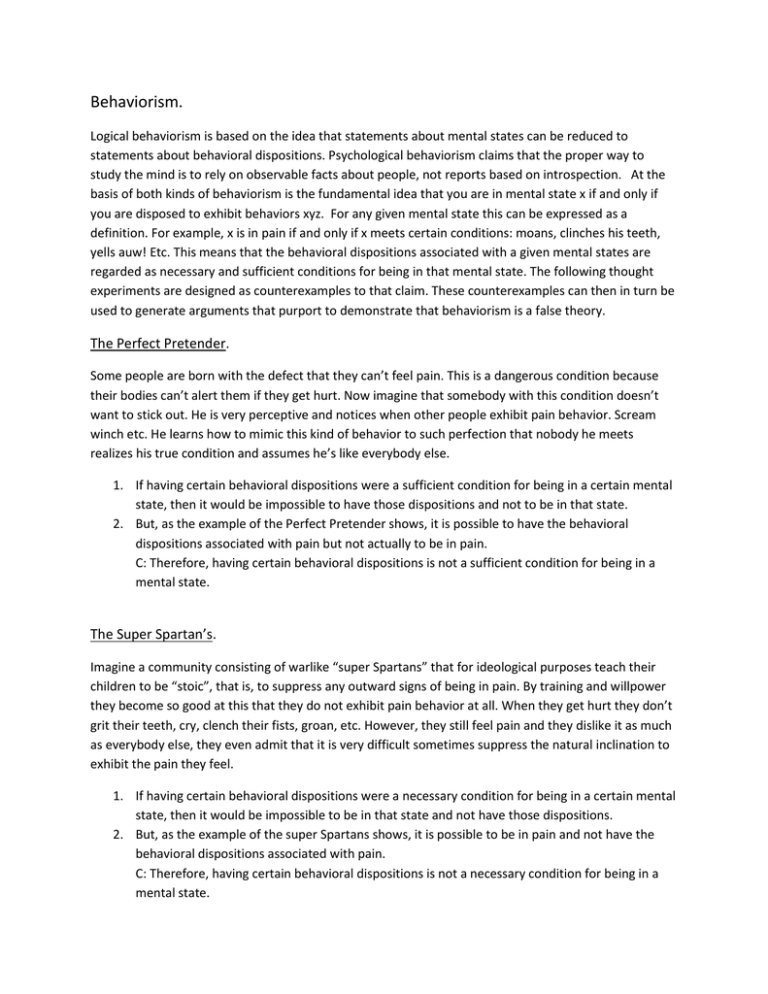Behaviorism. Logical behaviorism is based on the idea that
advertisement

Behaviorism. Logical behaviorism is based on the idea that statements about mental states can be reduced to statements about behavioral dispositions. Psychological behaviorism claims that the proper way to study the mind is to rely on observable facts about people, not reports based on introspection. At the basis of both kinds of behaviorism is the fundamental idea that you are in mental state x if and only if you are disposed to exhibit behaviors xyz. For any given mental state this can be expressed as a definition. For example, x is in pain if and only if x meets certain conditions: moans, clinches his teeth, yells auw! Etc. This means that the behavioral dispositions associated with a given mental states are regarded as necessary and sufficient conditions for being in that mental state. The following thought experiments are designed as counterexamples to that claim. These counterexamples can then in turn be used to generate arguments that purport to demonstrate that behaviorism is a false theory. The Perfect Pretender. Some people are born with the defect that they can’t feel pain. This is a dangerous condition because their bodies can’t alert them if they get hurt. Now imagine that somebody with this condition doesn’t want to stick out. He is very perceptive and notices when other people exhibit pain behavior. Scream winch etc. He learns how to mimic this kind of behavior to such perfection that nobody he meets realizes his true condition and assumes he’s like everybody else. 1. If having certain behavioral dispositions were a sufficient condition for being in a certain mental state, then it would be impossible to have those dispositions and not to be in that state. 2. But, as the example of the Perfect Pretender shows, it is possible to have the behavioral dispositions associated with pain but not actually to be in pain. C: Therefore, having certain behavioral dispositions is not a sufficient condition for being in a mental state. The Super Spartan’s. Imagine a community consisting of warlike “super Spartans” that for ideological purposes teach their children to be “stoic”, that is, to suppress any outward signs of being in pain. By training and willpower they become so good at this that they do not exhibit pain behavior at all. When they get hurt they don’t grit their teeth, cry, clench their fists, groan, etc. However, they still feel pain and they dislike it as much as everybody else, they even admit that it is very difficult sometimes suppress the natural inclination to exhibit the pain they feel. 1. If having certain behavioral dispositions were a necessary condition for being in a certain mental state, then it would be impossible to be in that state and not have those dispositions. 2. But, as the example of the super Spartans shows, it is possible to be in pain and not have the behavioral dispositions associated with pain. C: Therefore, having certain behavioral dispositions is not a necessary condition for being in a mental state. Identity Theory. The fundamental idea behind identity theory is that brain states and mental states are identical. Therefore a specific brain state will correspond to a specific mental state. The following thought experiments are meant as counterexamples to this claim Nagel’s Bat. We all believe that mammals such as mice, cats, and whales have experiences. If that’s the case, so most bats, they’re mammals after all. So, if that is the case, then there must be something that it is like to be a bat that is essential to the “bat experience”. However, since bats perceive the surrounding environment through sonar or echolocation, their experiences must be vastly different from ours. This is important for the mind-body problem because then there must be facts about what it’s like to be a bat, or any other organism that has conscious experiences that can only be known subjectively, or from the inside point of view of that organism so to speak. 1. If mental states are identical to brain states, then it’s possible to know everything about the mind by knowing everything there is to know about the brain. 2. But, as the bat example shows, it’s not possible to know everything about the mind by knowing everything about the brain. C: Therefore, mental states are not brain states. In other words, knowing everything about the brain is not sufficient to tell us everything about our mental states. The Autopsy of E.T. Suppose the evil scientists in E.T. manage to get hold of him before he can journey home to a galaxy far far away. In the name of science they make him undergo a battery of tests, then they kill him and perform an autopsy. They find out that inside his body there is a type of hydraulic system. Apparently, when you pinch him, for example, a bunch of little cavities inflate in his feet. When this happens, he is in pain; he groans and writhes and tells you to please stop. 1) If the identity theory were true, then it would be impossible for anything without a brain to have a mind. 2) But, as the example of E.T. shows things without our brains can have minds. C: So, the identity theory is not true, having a brain is not necessary for having a mind. Functionalism Functionalism. The fundamental idea behind functionalism is that mental states are defined by the causal relationships they have to each other and various sensory inputs and behavioral outputs. In other words, it’s the functional role that a mental state plays in relationship to other mental states and resulting behavioral outputs that is significant. This means, supposedly, that mental states have multiple relizability, i.e. , that if you can preserve the right kind of causal inputs and outputs, then you can preserve functionality. So, for example, if you gradually replaced parts of your brain with micro-processors and electric circuits that preserved the same functionality as the original brain cells, then the artificial brain would have the same mental states as the flesh brain. This is why proponents of artificial intelligence like to compare the mind to a computer program that can run on different types of hardware. There are a number of thought experiments that are designed to show that functionalism can’t be correct. Two such experiments are mentioned in the book on page 148 -151. Searle’s Chinese Room example is an attack on the idea that the mind can be compared to a computer program. In the same way that the person in the room has no understanding of Chinese but only manipulates strings of symbols, any computer processing information only “mindlessly” manipulates symbols. A computer doesn’t understand anything. The point can be expressed by the following argument: 1) If a computer could understand a language solely in virtue of running a program, then the man in the room would understand Chinese (because he is doing the same thing a computer is doing, namely, manipulating symbols in accordance with a set of rules). 2) But the man in the room doesn’t understand Chinese. C: So computers can’t understand a language solely in virtue of running a program. This means that David the robot, for example, who seems to be able to have conversations where he understands and responds to linguistic cues is clueless; nothing but symbol manipulation is going on in the circuits, David doesn’t really articulate thoughts or feelings. There are other counter examples like this. Ned Block’s outlandish Chinese Nation thought experiment (he picked China because the one billion inhabitants corresponds roughly to the number of neurons in a brain) is not in the book but it can also be used to generate an argument against functionalism. If the people of China were willing to participate in this experiment they could, at least for a short period of time, simulate what goes on in the human mind. Each Chinese is equipped with a two way radio that allows them to receive signals from each other and a system of satellites. The system controls a robot via radio signals. The point is that with the right kind of organization this system can mimic the electric signals in the brain, or simulate the mental states in a mind. But, even if we grant that such a simulation could be successful, it is far from clear that it feels like anything to be in a particular state of this system. But many mental states have a characteristic feel to them. However, even if the robot that is controlled by the signals it receives from the Chinese nation system runs away from an approaching danger and exhibits damage avoidance behavior and cries for help, it seems farfetched to say that there is anything in the system that is afraid. So even if the right input output signals are preserved, there is something essential to being afraid, the feeling of fear, that is missing. 1. If functionalism were true, then anything that had the right kind of functional organization would have a mind. 2. But as Block’s Chinese nation shows, it is not the case that anything that has the right functional organization would have a mind. C: So functionalism is false; having the right kind of functional organization is not a sufficient condition for having a mind. The other example from the book, the inverted spectrum case can be used to show that being in a particular functional state is not sufficient for being in a particular mental state. 1. If functionalism were true, then it would be impossible for people with the same functional organization to have different mental states. 2. But as the inverted spectrum case shows, it’s not impossible for people with the same functional organization to have different mental states. C: So functionalism is false; having a certain functional organization is not a sufficient condition for being in a certain mental state.




